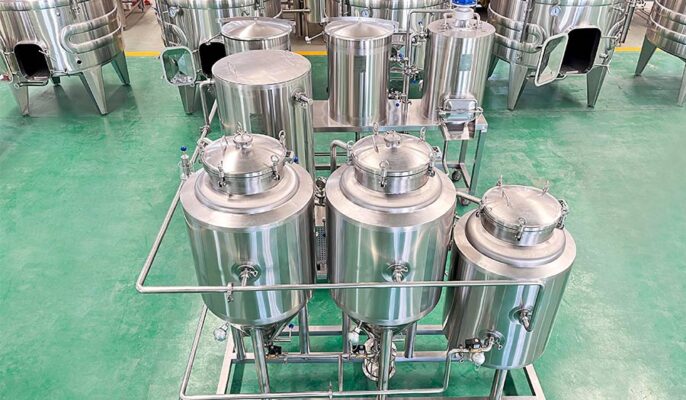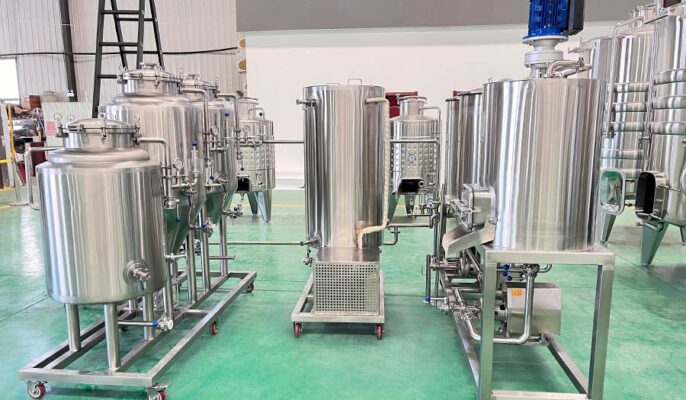Equipamento para fabrico de cerveja em casa é essencial para o processo de fabrico de cerveja. A produção de cerveja em casa não é apenas um passatempo divertido, mas também permite experimentar todo o processo, desde as matérias-primas até aos produtos acabados. O equipamento de fabrico de cerveja caseira está a tornar-se cada vez mais popular entre os amantes de cerveja e os cervejeiros que querem fabricar a sua cerveja artesanal. Este guia para principiantes ajuda-o a compreender rapidamente desde a escolha do equipamento correto até à familiarização com o processo de fabrico da cerveja.
O que é a produção caseira de cerveja?
O fabrico caseiro de cerveja consiste em produzir cerveja, vinho ou outras bebidas alcoólicas num ambiente doméstico. Normalmente, isto envolve várias etapas, desde a seleção das matérias-primas, a brassagem, a fervura, o arrefecimento e a fermentação até ao engarrafamento. A produção caseira de cerveja não só permite às pessoas desfrutar do prazer de poderem apreciar uma bebida doméstica, mas também um conhecimento mais profundo da arte da cerveja. Este processo permite que as pessoas ajustem a receita e o processo de acordo com os seus gostos e preferências para criar uma bebida única.
Processo de fabrico de cerveja caseira
- Preparar os materiais: Escolha as matérias-primas corretas de acordo com o tipo de álcool que está a produzir. Por exemplo, as matérias ricas em amido, como os cereais, podem ser utilizadas para a produção de cerveja, enquanto as frutas frescas e não podres podem ser utilizadas para a produção de vinho de fruta.
- Triturar: Colocar os grãos esmagados de molho em água quente para converter o amido em açúcares fermentáveis.
- Ebulição: Ferver o mosto e adicionar lúpulo para aumentar o amargor, o sabor e o aroma.
- Arrefecimento: Arrefecer rapidamente o mosto até uma temperatura adequada para a fermentação.
- Fermentação: Adicione a levedura ao barril de fermentação e mexa uniformemente. A levedura fermenta o açúcar do mosto em álcool e fermenta.
- Biberão: Lavar e esterilizar os biberões, as tampas e os tampões. Os biberões podem ser de vidro ou de plástico.
- Maturação: Selar a boca da garrafa com uma tampa e colocar a prateleira da garrafa num ambiente seguro. O tempo de maturação depende do tipo de bebida e da preferência pessoal. Normalmente, são necessárias mais 2 a 4 semanas para obter o melhor sabor, e o tempo de maturação do vinho pode ser mais longo.
- Limpeza e manutenção: Após cada fabrico de cerveja, limpar e esterilizar cuidadosamente todo o equipamento para evitar a contaminação.

Equipamento essencial para a produção caseira de cerveja
Panela de cerveja
A panela de cerveja é uma peça de equipamento no processo de fabrico de cerveja caseira. É utilizada para ferver o mosto e é uma etapa fundamental para garantir o sabor e a qualidade da cerveja ou de outras bebidas. A panela de infusão desempenha um papel central no fabrico de cerveja caseira. Escolher a panela certa e utilizá-la corretamente pode melhorar significativamente a eficiência da produção de cerveja.
Fermentador
O fermentador é um dos equipamentos mais importantes para a produção caseira de cerveja. É utilizado no processo de fermentação para converter os açúcares em álcool e gás. O fermentador é geralmente feito de plástico ou vidro de qualidade alimentar e está equipado com uma tampa selada e uma câmara de ar. As vantagens dos fermentadores de plástico são o facto de serem baratos, leves e fáceis de limpar; os fermentadores de vidro são mais fáceis de observar o processo de fermentação, mas são relativamente pesados e frágeis.
Câmara de ar
A câmara de vácuo é utilizada para permitir a respiração durante o processo de fermentação, evitando que o ar e os tubos brônquicos entrem no fermentador. O airlock é normalmente um pequeno dispositivo de plástico com duas entradas e uma pequena câmara cheia de líquido. Evita a entrada de contaminantes no fermentador, permitindo a saída de gases.
Agitador
O agitador é utilizado para misturar o mosto e a levedura para garantir a uniformidade. Os fabricantes de cerveja caseira de fermentação podem optar por utilizar um agitador manual ou um agitador elétrico. Embora os agitadores eléctricos sejam comparáveis em preço, poupam tempo e energia.
Refrigeradores
O mosto fervido precisa de ser arrefecido rapidamente para evitar alterações de sabor causadas pelo sobreaquecimento. Os refrigeradores podem reduzir rapidamente a temperatura do mosto para garantir que a levedura possa iniciar a fermentação à temperatura ideal. Os refrigeradores comuns incluem os refrigeradores de tabuleiro e os refrigeradores de serpente.
Equipamento de engarrafamento
Os utensílios de engarrafamento incluem garrafas, tampas de garrafas, tampas de garrafas e escovas de garrafas. As garrafas podem ser de vidro ou de plástico, mas as de vidro permitem manter melhor a qualidade da cerveja. As tampas das garrafas são utilizadas para selar a boca da garrafa, a fim de evitar a oxidação e a contaminação da cerveja.
Tipos de equipamento de fabrico de cerveja caseira
O equipamento certo depende das suas competências actuais, do seu nível de interesse e do seu orçamento:
|
TIPO DE SISTEMA |
DESCRIÇÃO |
|
Cerveja básica em saco (BIAB) |
Sistema tudo-em-um de nível básico e económico com caldeira integrada e reservatório único |
|
Kit intermédio |
Atualização com tina de mistura e caldeira de ebulição separadas. Melhor controlo da temperatura. |
|
Avançado All-Grain |
Recipientes múltiplos de alta qualidade para triturar, ferver e fermentar para obter a melhor qualidade |
|
Cervejaria eléctrica |
Elementos de aquecimento eléctricos automatizados para um controlo preciso |

Como escolher o equipamento de fabrico de cerveja caseiro adequado?
Escolha o tamanho certo do equipamento de fabrico de cerveja
Num pequeno Sistema de Nano Cervejaria:
Sistema de 5 BBL x 2 cervejas por semana x 50 semanas = 500 BBL por ano
Sistema de 5 BBL x 3 cervejas por semana x 50 semanas = 750 BBL por ano
Num meio Sistema de microcervejaria:
Sistema de 10 BBL x 3 cervejas por semana x 50 semanas = 1500 BBL por ano
Sistema de 10 BBL x 6 cervejas por semana x 50 semanas = 3000 BBL por ano
Numa grande Sistema de cervejaria comercial:
Sistema de 30 BBL x 10 cervejas por semana x 50 semanas = 15000 BBL por ano
30 BBL System x 15 Brews per Week x 50 Weeks = 22500 BBL per Year
Once you know your target production volume, we can determine the maximum production efficiency of your brewery design based on your production volume. For example, a nano brewery or brewhouse system is typically between 2 – 5 BBL and produces 200 – 750 barrels of beer per year. A craft beer system is typically between 10-15 BBL and produces 1,500 – 4,500 barrels of beer per year.
Escolher os materiais corretos
The materials used in the manufacturing process of brewing equipment can have a significant impact on the price of the equipment. Brewing equipment can be made from a variety of materials, including stainless steel, copper, aluminum, and plastic.
- Stainless steel: Stainless steel is one of the most commonly used materials in brewing equipment because it is durable, corrosion-resistant, and easy to clean. But it is also more expensive than other materials, which can increase the price of brewing equipment.
- Copper: Copper is another popular brewing equipment material because it has excellent thermal conductivity. However, it is also more expensive than stainless steel and more difficult to clean and maintain.
- Aluminum: Aluminum is a more affordable alternative to stainless steel and copper, but it is not as durable and can react with certain chemicals during the brewing process, affecting the taste of the beer.
- Plastic: The cheapest option for brewing equipment, but also the least durable and more difficult to clean and maintain. It is often used for home brewing or small-scale operations.
Orçamento
It is important to determine your budget before looking for brewing equipment, as prices can vary greatly depending on the type of equipment and the quality of the materials used. For example, a small home brewing set may cost a few hundred dollars, while a large commercial brewing system may cost tens of thousands of dollars or more.
It is also important to consider the long-term costs and benefits when considering the purchase price of brewing equipment. Cheaper options may save money in the short term but may end up costing more in the long term due to poorer quality or more frequent repairs. On the other hand, more expensive options may cost more upfront but have better quality and fewer repairs, ultimately saving money in the long run.
Escolher o melhor fornecedor
It is important to consider the quality of technical support provided by the manufacturer. This includes the availability of technical support personnel, their knowledge and expertise, and the manufacturer’s responsiveness to support requests.
Some manufacturers may provide technical support via phone or email, while others may provide on-site support. It is important to choose a manufacturer that provides technical support in a way that suits your needs and requirements.
Another factor to consider is the warranty provided by the manufacturer. A good warranty can provide peace of mind and avoid unexpected repair costs. It is important to carefully review the warranty provided by the manufacturer and make sure it covers any potential problems that may arise.
Apoio ao serviço pós-venda
After-sales support includes a range of services and benefits provided by the manufacturer or seller of brewing equipment after the sale. These include technical support, maintenance and repair services, replacement parts, training and education, and warranties.
If the manufacturer or seller offers a strong after-sales support program, it can increase the value of the brewing equipment by ensuring that the brewing equipment is running at optimal performance and reducing the likelihood of failures or other problems. This can also give buyers more confidence in their purchase and help them feel more comfortable investing in higher-priced equipment.
FAQ
Que tamanho de sistema devo escolher para um principiante?
Start with a brew kettle BIAB or kit of at least 5 gallons. This will allow you to brew standard 5-gallon batches to fill 12-ounce bottles or kegs.
Como posso limpar e higienizar o meu equipamento de fabrico de cerveja?
Use a dedicated brewing equipment cleaner or bleach and rinse thoroughly. Make sure all equipment is completely dry before use to avoid residual cleaning agents.
Como é que guardo o meu equipamento de fabrico de cerveja?
Brewing equipment should be thoroughly cleaned and dried after use and stored in a dry, cool place away from direct sunlight and moisture.
Como posso prolongar a vida útil do meu equipamento de fabrico de cerveja?
Clean and maintain it regularly to avoid damage or aging of the equipment and follow the manufacturer’s recommendations for operation and storage.




